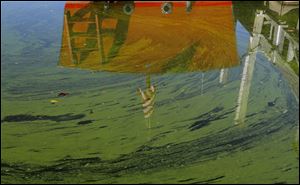
To the editor: What farmers can do to help Lake Erie
6/10/2018
A docked boat is reflected in the algae-covered water of Lake Erie’s Maumee Bay in Oregon, Ohio.
I have been involved in farming all my life, and Lake Erie has had problems as far back as I can remember. In the 1970s, the city blamed the farmers for nitrogen run-off and the farmers blamed the city for phosphorous run-off. Nothing got done.
There are three problems with the lake: phosphate run-off, nitrogen run-off, and soil erosion.
The first problem can be taken care of by stopping the use of leachable fertilizers. The second could largely be taken care of by inter-cropping corn with soybeans and using chicken manure. The third, by growing cover crops like buckwheat, radishes, rye, or a mixture of things to keep the ground covered year-round.
There are at least two sources of phosphate that do not run off. The first is called Soft Rock Phosphate. All 20 percent P205 is available to the plant. It is available from Ohio Earth Food. The other is Tennessee Brown Phosphate. It has 22.7 percent P205 and is available from Crop Services International. I have used both with great results.
According to Arden Anderson, you an grow corn with 40 pounds nitrogen per acre when you have enough calcium, since it is the calcium that makes the corn grow.
CHRIS DIETRICH
Elmore
Editor’s note: Farmers and others interested in non-run-off phosphate sources can contact Ohio Earth Food at 330-877-9356 or Crop Services International at 800-260-7933.
Click here to submit a letter to the editor
Communities change over time, but the Catholic Church does not
The disposition of Saint Anthony Church is a very sensitive subject and a little perspective helps. (June 3, “Kaptur, Kapszukiewicz call on diocese to halt St. Anthony’s demolition”). In 1880s the Diocese of Cleveland, which Toledo was then part of, authorized the erection of several ethnic parishes throughout northern Ohio in response to the massive influx of immigrants. In many instances a French, German, Polish, or Slovak parish would be built within blocks of each other. Even though the same Mass would be celebrated in Latin at every one of those churches, the ethnic communities nestled around those parishes for mutual support. Now, 125 years later, those ethnic communities have dissipated and church attendance is a fraction of the original numbers. Lower attendance results in decreased revenue needed to maintain these structures.
Many of the majestic churches that were built no longer house the thriving communities that erected them. It is important to understand that a church building is not the Roman Catholic Church, and while a building holds memories, it is truly empty if a community does not use it. With changing demographics, the Diocese of Toledo, like many dioceses throughout the country, is trying to balance the need to keep a parish open and maintain the structures, some of which may or may not be of any architectural significance. The diocese’s primary responsibility must be to the living communities of faithful, not in preserving monuments or museums to the past.
Dioceses take a lot of criticism for closing or dismantling church buildings, but where are the people who made these parishes possible in the first place? If the faith community is not there to support the parish structure who is responsible for maintaining it? The public? Catholic Church buildings are not the only church buildings standing vacant and falling into ruin. Does the community at large have to take charge and save all these other buildings as well? What about other historical and architectural treasures in our community?
MICHAEL SARRA
Rossford